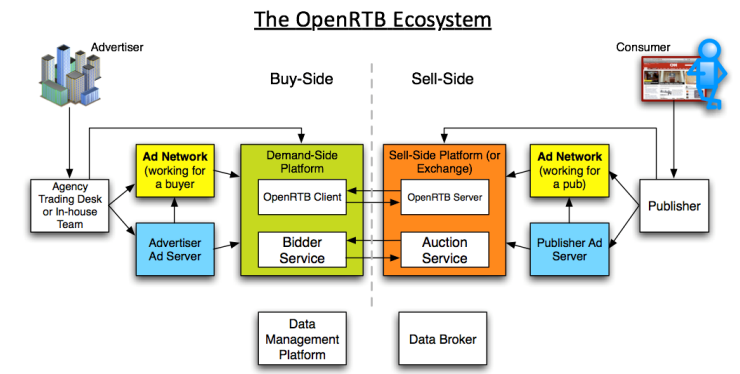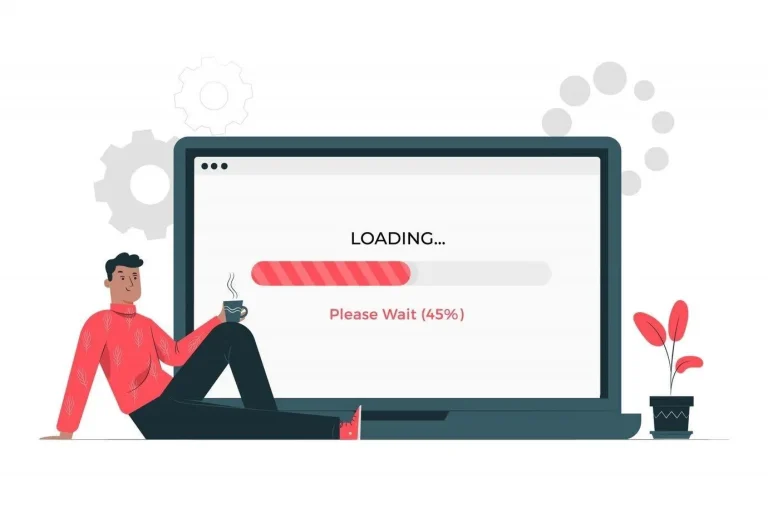Managing your ad inventory can sometimes feel like a high-wire act. You’re constantly coordinating with multiple ad exchanges and negotiating deals with countless potential buyers while trying to get the most revenue from your ads. It’s like spinning plates – if one thing goes wrong, it could all come crashing down. Sounds challenging, right?
Now, imagine if there was a tool that could simplify this process, allowing you to automate the negotiation and auctioning of your ad space to the highest bidder. This isn’t just a dream; it’s a reality with OpenRTB.
You might be asking, “What’s this RTB in OpenRTB?” Think of it as an ultra-fast, automated auction for digital ad spaces. Every time a webpage loads, an auction is conducted within milliseconds to sell the ad space to the highest bidder. This is RTB (Real-Time Bidding) – a real-time process of buying and selling ads.
But here’s where things get interesting – OpenRTB. It’s like the supercharged version of RTB – a common language that makes these auctions work smoothly across different platforms. Developed by the Interactive Advertising Bureau (IAB), OpenRTB streamlines these real-time negotiations, ensuring everyone involved speaks the same language. It’s the behind-the-scenes maestro conducting the orchestra of digital advertising.
We get it – understanding OpenRTB might seem like trying to decode hieroglyphics. But don’t fret – we’re here to help! In this blog post, we’re going to translate this complex concept into simple, everyday language. Whether you’re new to OpenRTB, looking to improve your current setup, or simply curious about what’s next in digital advertising, you’re in the right place.
Ready to turn the high-wire act of managing your ad inventory into a walk in the park? Let’s dive in!
Table of Contents
What is OpenRTB?
💡 OpenRTB is a standard protocol that enables real-time transactions of ad inventory between advertisers and publishers.
It serves as the backbone of the programmatic buying and selling of ads, essentially turning the process into a common language everyone involved can understand.
Imagine OpenRTB as a translator, ensuring all parties – the publishers, advertisers, and ad exchanges – are on the same page. It allows publishers to sell their website’s ad space swiftly and efficiently to the highest bidder, removing the complexity often associated with ad transactions. By simplifying these interactions, OpenRTB paves the way for a smoother, more profitable ad-selling process.
Here’s why OpenRTB is useful to you as a publisher:
- Speed: OpenRTB enables real-time transactions. The moment a visitor lands on your website, your ad space is sold, and the ad is displayed instantly.
- Efficiency: OpenRTB connects you with multiple buyers at the same time, which increases the chances of a higher price for your ad space.
- Control: With OpenRTB, you have control. You decide the minimum bid price and who gets to bid.
- Transparency: OpenRTB promotes transparency. You can see the entire transaction process and know who’s buying at what price.
How Does OpenRTB Work?
If OpenRTB sounds like a magical fix to your ad sales woes, you’re probably wondering how it works. Let’s pull back the curtain:
- The ad request: When a visitor lands on your website, an ad request is sent out. This includes information like the user’s demographics, browsing habits, website context, and more. All these data points help potential buyers understand the value of your ad space.
- The auction: Now, this ad request doesn’t just go to one potential buyer. It’s broadcast to numerous buyers simultaneously. These buyers, who have their criteria for the perfect ad spot, will decide whether your ad request fits their needs. If it does, they enter an auction. Each buyer bids for your ad space based on the value they see in it.
- The winner: The highest bid wins, but there’s a catch – the winning buyer pays only a cent more than the second-highest bid. This is called the second-price auction model, and it ensures fair play. If it is a first-price auction model, the winning buyer has to pay the exact amount that they bid.
- The ad display: Finally, the winning ad is instantly displayed on your website. This entire process, from the visitor landing on your site to the ad being displayed, happens within milliseconds.

Source: High-level communication between parties using openRTB.
SSPs and DSPs communicate the bid request and responses via OpenRTB. The SSP issues a bid request, and the DSP replies with a bid. Both the request and response are conveyed in JSON (Javascript Object Notation). It is a lightweight format for transmitting data. It transmits auction attributes, objects, and the value needed to buy and sell impressions.
Benefits of OpenRTB
Now that you understand how OpenRTB works, you’re probably wondering about its benefits for you as a publisher. Here are a few:
- Increased revenue: Since multiple buyers bid for your ad space, the competition could drive up the price. It’s simple economics – when demand is high, the price increases.
- Better fill rates: With OpenRTB, every ad request has the potential to result in an ad being displayed. This means less empty ad space on your site, leading to better fill rates.
- Greater efficiency: No need to negotiate with each buyer individually. OpenRTB simplifies the ad-selling process, allowing you to focus on creating quality content for your website.
- Flexibility: OpenRTB simplifies the connection between sellers and buyers with a single protocol for data sharing and ad delivery. And its widespread adoption gives marketers extra flexibility to connect with new partners.
- Reduce development costs: Sell-side and buy-side platforms can make multiple integrations faster and cheaper with OpenRTB, which reduces the development cost. Ultimately, it allows for internal business innovation at a deeper level.
- Improved user experience: Serving relevant ads based on user data not only leads to higher ad revenue but also ensures a positive user experience. When visitors encounter ads that align with their interests, they’re less likely to be annoyed and more likely to engage with your content. To delve deeper into striking the right balance between your ad strategy and user experience, check out our article on Finding the Right Balance Between Ads and User Experience.
That’s a broad look at how OpenRTB works and how it can benefit you. But how do you get started with OpenRTB?
Getting Started with OpenRTB
Alright, you’ve understood what OpenRTB is and how it works. You’re ready to get started, but where do you begin? Here’s a step-by-step guide:
Step 1: Choose your SSP
Your first step in the OpenRTB journey is to choose a Supply-Side Platform (SSP). This platform bridges you (the publisher) and potential buyers. It sends out your ad requests and conducts the real-time auction. Some popular SSPs compatible with OpenRTB include Google Ad Exchange (AdX), Magnite, PubMatic, and OpenX.
Step 2: Set up your rules
Next, you need to set up your rules or preferences. These include the minimum bid price you’re willing to accept, the type of ads you want to display, and the kind of buyers you’re willing to interact with. This gives you control over the ad-selling process.
Step 3: Monitor and optimize
Once your SSP is set up and your rules are in place, you’re good to go. But your job doesn’t end there. It’s important to monitor your ad performance and optimize your rules based on your observations.
Best Practices for Implementing OpenRTB
To maximize the potential of OpenRTB for your digital ad space, adhere to the following best practices.
Proactive fraud prevention: Ad fraud is a constant challenge. To protect your ad revenue, apply robust fraud prevention measures such as domain verification and implementing ads.txt. Update these measures regularly to counter evolving fraudulent techniques.
Adherence to OpenRTB version updates: OpenRTB’s continuous development aims to address the dynamic nature of digital advertising. Stay abreast of updates to maximize the advantages of new features and improvements.
SSP rules adjustment: Your audience, content, and revenue objectives are not static, nor should your SSP rules. Adjust factors like your minimum bid price, ad types, and preferred buyers periodically to optimize revenue generation.
User experience consideration: Striking a balance between maximizing ad revenue and maintaining an enjoyable user experience is crucial. Irrelevant or intrusive ads can negatively impact user experience and eventually reduce your website traffic.
Common Mistakes to Avoid
Here are some common pitfalls to avoid when implementing OpenRTB.
Ignoring diverse ad formats: Limiting your focus to desktop ad formats will undermine your revenue potential. OpenRTB supports a variety of ad formats, including mobile and video. Ensuring that you’re tapping into these options will enhance your reach and revenue opportunities.
Setting inappropriate floor prices: Overpricing can deter potential buyers and leave you with unsold ad inventory. It’s important to set a realistic floor price that reflects the value of your ad space but remains attractive to advertisers.
Neglecting performance analysis: Successful OpenRTB implementation requires consistent performance tracking. Neglecting to monitor your ad sales performance and failing to adjust strategies based on this data can lead to inefficiencies and lower revenue.
Breaking Down OpenRTB Versions
The world of programmatic advertising is continuously evolving, and so is OpenRTB. Let’s understand the key versions and how they can benefit you:
OpenRTB 3.0: A step up in the game, OpenRTB 3.0 was a significant revamp of the protocol. It was designed to tackle the increasing market demand for more security, transparency, and trust in programmatic advertising. This version works hand in hand with AdCOM 1.0, forming a robust and streamlined ecosystem. Its updates aim to reduce ad fraud and create a dependable programmatic environment for you, the publisher.
OpenRTB 2.5 and 2.6: These versions were about fine-tuning, bringing incremental improvements for better functionality and security in real-time bidding. For instance, OpenRTB 2.6 made room for header bidding, which lets multiple SSPs bid on your inventory simultaneously, enhancing revenue potential.
IAB Tech Lab recently updated the OpenRTB 2.0 with the following capabilities.
OpenRTB v2.6-202309 (September 2023): New attributions in the project: Bidrequest nd Deal (guaranteed). This update also includes a new attribute to set floor prices for video and audio creatives.
OpenRTB v2.6-202303 (April 2023): This includes changes in the ad refresh system with minimum exposure time, ad refresh triggers, and timestamp of when the ad impression is served.
OpenRTB v2.6-202211 (November 2022): This includes process details for versioning, contributing, and monthly release cadence.
OpenRTB 2.6 (April 2022): This update contains changes to support CTV buying and selling.
OpenRTB 2.5 (December 2016): This update includes support for flexible aspect ratios and video placement.
In essence, these versions of OpenRTB, each with unique features and enhancements, are designed to simplify your life as a publisher and make your ad space more lucrative. It’s all about staying in the loop with these updates to make the most of them.
OpenRTB vs. RTB
RTB is a broader term that denotes the real-time auction happening within milliseconds. On the other hand, OpenRTB supplies the standards and protocol for RTB transactions. It includes a standardized and consistent way to transfer essential information about impressions and ad creatives between buyers and sellers.
In OpenRTB, the information needed before and after bidding can be accessed without direct contact between both parties. The purpose of OpenRTB is to enforce industry standards for interoperability and communication between buyers and sellers, eliminating development costs and fostering speedy auctions.
OpenRTB 3.0
IAB introduced OpenRTB 3.0 to focus more on security and transparency in the ad environment. As the supply chain is getting more and more complex, this OpenRTB version serves as a protocol that brings out the desired security and transparency in the system. To achieve that, IAB added certain features to the existing RTB protocol in the AdCom 1.0. We have covered a few of them here.
Ads.cert: It is an extra safeguard to Ads.txt. This enables publishers and other links in the supply chain to stamp every impression with the authenticated and encrypted signature to show advertisers that it is not tampered with. This way, ad fraud can be reduced, and buyers can be prevented from buying false impressions under false names.
Creative approval and rejection: The OpenRTB 3.0 also includes a protocol that supply and demand partners can use to approve or reject ad creatives. This way, the publishers can ensure quality ads on their websites and prevent their websites from poor quality ads.
Duplicate code reduction: Version 3.0 tackles the problem of bid request overload in the programmatic system. Previously, an ad exchange selling different types of inventory for publishers would need separate specifications for each inventory category. That specification unnecessarily contains duplications like publisher IDs and content categories. These specifications are almost the same for all inventories, and it created duplication, which was addressed with the OpenRTB version 3.0. Ultimately, it reduced the traffic volumes and latency issues.
However, despite all these useful features, Open RTB 3.0 has a lesser adoption rate.
Why is there a lesser adoption of OpenRTB 3.0?
The two main problems that are preventing the adoption of OpenRTB 3.0 are:
- No backward compatibility
- Efforts from the engineering team are needed to update the existing setup for the 3.0 version
Jim Butler, co-chair of the IAB Tech Lab OpenRTB working group, addressed the adoption problem in an interview with eMarketer. He gave a potential solution by encouraging ad exchanges to make the supply and demand available for the 3.0 version as possible so that every marketer can relish transparency and security in their ecosystem.
Wrapping Up the OpenRTB Journey
Understanding and using OpenRTB can truly change the game for digital publishers. It simplifies the digital advertising process, ensuring you’re efficiently selling your ad space to the highest bidder. We hope this guide helps demystify OpenRTB for you and brings you one step closer to making the most of your ad inventory.
Remember, if you have any questions or need further insights about implementing OpenRTB, we’re here to help. Get in touch with us for any assistance in maximizing your ad revenue. We’re just a message away!
FAQs
- What is OpenRTB?
OpenRTB is a protocol in digital advertising for standardizing information exchange during real-time ad bidding. - What are the Benefits of OpenRTB?
OpenRTB enhances ad transaction efficiency, reduces miscommunication through a universal language, optimizes publishers’ revenue by enabling sales to the highest bidder, and promotes transaction transparency. - How does OpenRTB work?
OpenRTB works via real-time auctions. A publisher’s site sends a bid request for available ad space to multiple advertisers. They review and place their bids, with the highest bidder’s ad displayed on the publisher’s site – all within milliseconds.























